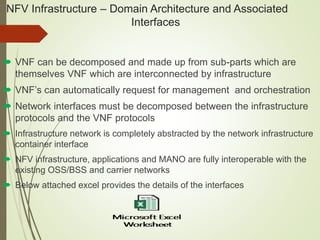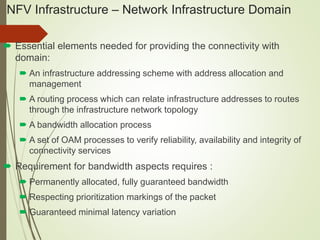Network Function Virtualization : Infrastructure Overview
- 1. Network Function Virtualisation - Infrastructure Overview Neelima Sharma
- 2. The content of this presentation is taken from the ETSI NFV specifications and from various presentations available on internet
- 3. What is covered… NFV Infrastructure – Overview NFV Infrastructure – Architecture NFV Infrastructure – NFVI and Cloud Computing NFV Infrastructure – Domain architecture and associated interfaces NFV Infrastructure – Compute Domain NFV Infrastructure – Hypervisor Domain NFV Infrastructure – Network Domain NFV Infrastructure – Challenges
- 4. NFV Infrastructure - Overview Below figure illustrate the section related to the Infrastructure
- 5. NFV Infrastructure - Overview NFV Infrastructure architecture is primarily concerned Compute Domain HyperVisor Domain Infrastructure Domain Hypervisor Domain provides Sufficient abstraction of the hardware for the portability of the Software appliances Provide compute domain resources to the S/W appliances VM machines Provides management interfaces to the orchestration and management system
- 6. NFV Infrastructure – Reference Architecture Framework
- 7. NFV Infrastructure – Architectural Principles of VNF System engineering approach of defining components as functional block and their interconnection After network functions are virtualised
- 8. NFV Infrastructure – Architectural Principles of VNF Behavior of functional block is determined by Static transfer function of the functional blocks Dynamic state of the functional blocks Inputs it received in its interface Virtualization resulted in the following Division of functional block between a host function and VNF Creation of new container interface between the host function and the VNF it is hosting Division of the interface between the two network functions which are now virtualized between infrastructure interface and a virtualized interface Relationship between VNF and host VNF is a configuration of the host function VNF is an abstract view of the host function when configured by VNF
- 9. NFV Infrastructure – Architectural Principles of VNF NFV architecture is defined using the following entities Host functions with their associated offered container interfaces and associated infrastructure interfaces VNF with their associated used container interfaces and virtualized interfaces
- 10. NFV Infrastructure – Management and Orchestration of VNF Network functions have an interface ( North bound interface) to a management and orchestration function
- 11. NFV Infrastructure – NFVI and Cloud Computing Five essentials characteristics of cloud services On demand self service Broad network access Resource pooling Rapid elasticity Measured service Service models impacting NFVI SaaS VNF’s are software applications on cloud VNF’s are executed according to a private cloud model Example is VNFaaS
- 12. NFV Infrastructure – NFVI and Cloud Computing PaaS Service model consistent with deployment by network operators of services VNPaaS is a use case IaaS Capability provided is the provisioning of compute, storage and communication resources for the application to run Good use case is NFVIaaS
- 13. NFV Infrastructure – Domain Architecture and Associated Interfaces
- 14. NFV Infrastructure – Domain Architecture and Associated Interfaces VNF can be decomposed and made up from sub-parts which are themselves VNF which are interconnected by infrastructure VNF’s can automatically request for management and orchestration Network interfaces must be decomposed between the infrastructure protocols and the VNF protocols Infrastructure network is completely abstracted by the network infrastructure container interface NFV infrastructure, applications and MANO are fully interoperable with the existing OSS/BSS and carrier networks Below attached excel provides the details of the interfaces
- 15. NFV Infrastructure – Compute Domain Role of the Compute domain is to provide the interface to the network infrastructure domain but does not support network connectivity Principal elements of the compute domain CPU Network Interface Controller (NIC) Storage Server Chasis Remote management Functional description of the compute domain needs to reference the speed of execution
- 16. NFV Infrastructure – Compute Domain Primary characteristics of storage are : Latency in accessing a specific state held in storage Size of the storage Volatility or persistence of the storage Scope of Compute node includes CPU with storage Hardware for encryption and decryption Packet switching Accelerated packet forwarding
- 17. NFV Infrastructure – Hypervisor Domain Mediates the resources of the computer domain to the virtual machines which includes : CPU NIC and so on …
- 18. NFV Infrastructure – Hypervisor Domain Forthcoming hardware improve the performance of VM’s which includes multicore processors supporting multiple independent parallel threads of execution system-on-chip processors that integrate multiple cores, DRAM interfaces, network interfaces, storage,interfaces and hardware acceleration for security, multicore processing, networking, storage and application acceleration. specific CPU enhancements/instructions to control memory allocation and direct access on I/O devices to VM memory allocations PCI-e bus enhancements, notably SR-IOV
- 19. NFV Infrastructure – Hypervisor Domain Specific features of hypervisor support for high performance NFV VMs include exclusive allocation of whole CPU cores to VMs direct memory mapped polled drivers for VMs to directly access the physical NICs using user mode instructions requiring no ‘context switching’ direct memory mapped polled drivers for interVM communications again using user mode instructions requiring no ‘context switching vSwitch implementation as a high performance VM again using direct memory mapping and user mode instructions requiring no ‘context switching’
- 20. NFV Infrastructure – Hypervisor Domain Architecture Below figure illustrates the hypervisor domain architecture
- 21. NFV Infrastructure – Network Domain Reference point Architecture Below figure illustrates the network domain reference point architecture in the NFVI
- 22. NFV Infrastructure – Network Infrastructure Domain Roles of network domains includes : Communication channel between the VNFC’s of a distributed VNF Communication channel between different VNFs Communication channel between VNFs and their orchestration and management Communication channel between components of the NFVI and their orchestration and management Means of remote deployment of VNFCs Means of interconnection with the existing carrier network
- 23. NFV Infrastructure – Network Infrastructure Domain Essential elements needed for providing the connectivity with domain: An infrastructure addressing scheme with address allocation and management A routing process which can relate infrastructure addresses to routes through the infrastructure network topology A bandwidth allocation process A set of OAM processes to verify reliability, availability and integrity of connectivity services Requirement for bandwidth aspects requires : Permanently allocated, fully guaranteed bandwidth Respecting prioritization markings of the packet Guaranteed minimal latency variation
- 24. NFV Infrastructure – Network Infrastructure Domain Requirement for infrastructure network and VNF protocols to work together Common Header MAC header associated with NIC should be understood by both Transparent encapsulation Carry the packet from the VNFC as a transparent payload and must add a completely new header for transport by the infrastructure network Address binding Mac addresses presented to the VNFC must be bound to infrastructure network addresses
- 25. NFV Infrastructure – Challenges in Performance General recommendations to apply to network SW design SW requiring high performance should be partitioned in independent modules running in different threads Modules should have independent memory structures in order to avoid OS deadlocks Modules should communicate each other in pipeline structures, minimising the use of the OS as an intermediate step OS interruptions should be reduced, if possible, to zero, due to its high consumption of CPU cycles The use of OS network stacks should be avoided Network cards and other peripherals should communicate directly with the modules through memory
- 26. NFV Infrastructure – Challenges in Interconnection of VNF

























